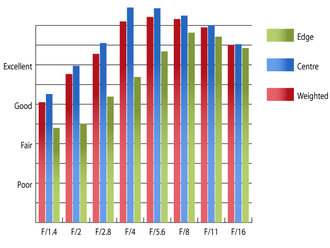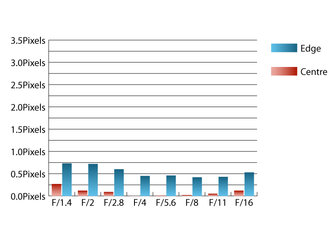Nikon AF Nikkor 50mm f/1.4D Lens Review
Nikon AF Nikkor 50mm f/1.4D Performance
At maximum aperture, sharpness in the centre of the frame approaches very good levels, but the clarity towards the edges of the frame falls behind somewhat, falling short of fairly good levels. Stopping down improves performance across the frame with outstanding levels of sharpness being achieved in the centre from f/2.8 onwards and peak sharpness across the frame being achieved between f/5.6 and f/8.  Resolution at 50mm | How to read our chartsThe blue column represents readings from the centre of the picture frame at the various apertures and the green is from the edges. Averaging them out gives the red weighted column.The scale on the left side is an indication of actual image resolution. The taller the column, the better the lens performance. Simple. For this review, the lens was tested on a Nikon D700 using Imatest. |
Levels of chromatic aberrations are a little on the high side towards the edges of the frame at fast apertures, but fringing decreases as the lens is stopped down to below 0.5 pixel widths. The levels at wide apertures may become visible in images with high contrast edges placed near the edges of the frame.
 Chromatic aberration at 50mm | How to read our chartsChromatic aberration is the lens' inability to focus on the sensor or film all colours of visible light at the same point. Severe chromatic aberration gives a noticeable fringing or a halo effect around sharp edges within the picture. It can be cured in software.Apochromatic lenses have special lens elements (aspheric, extra-low dispersion etc) to minimize the problem, hence they usually cost more. For this review, the lens was tested on a Nikon D700 using Imatest. |
As is typical with older lens designs, falloff of illumination towards the corners of the frame is very pronounced at fast apertures. At f/1.4 the corners are over three stops darker than the image centre.
The effect is so strong that images taken with the lens stopped down may need exposure compensation as the camera will believe the scene is darker than it actually is when metering wide open. Visually uniform illumination is achieved with the aperture stopped down to f/4 or beyond.
A classic trait of older prime lenses with a fast maximum aperture is that they often produce quite pronounced barrel distortion. This lens is no exception, with Imatest detecting 1.95% barrelling. This level will be noticeable in images with straight lines towards the edges of the frame. Luckily the distortion pattern is uniform across the frame, so adjustments should be easy to apply in image editing software afterwards.
The design of this lens pre-dates any fancy nano-crystal coatings, and as a result contrast is reduced when shooting into the light at wide apertures and flare can be an issue in very harsh lighting conditions.
Add your message
Login required
Please login here or if you've not registered, you can register here. Registering is safe, quick and free.
Please login here or if you've not registered, you can register here. Registering is safe, quick and free.
photodo Stats
1102 lenses
428 MTF tests
74 in-depth photodo reviews
100+ users join each day
Help the lens community by reviewing or rating a lens today via our lens search
428 MTF tests
74 in-depth photodo reviews
100+ users join each day
Help the lens community by reviewing or rating a lens today via our lens search
Latest Lens Reviews
- Chinon 28mm f/2.8 Vintage Lens Review
- Canon EF 70-200mm f/4L IS II USM Lens Review
- Samyang AF 85mm f/1.4 EF Review
- Sigma 70mm f/2.8 DG Macro Art Review
- Samyang AF 24mm f/2.8 FE Review
- Meike 50mm f/1.7 Review
- Tamron 70-210mm f/4 Di VC USD Review
- Lensbaby Burnside 35mm f/2.8 Review
- Asahi Super Takumar 50mm f/1.4 Review
- Asahi Super-Multi-Coated Takumar 135mm f/3.5 Review
